The Zeppelin Museum
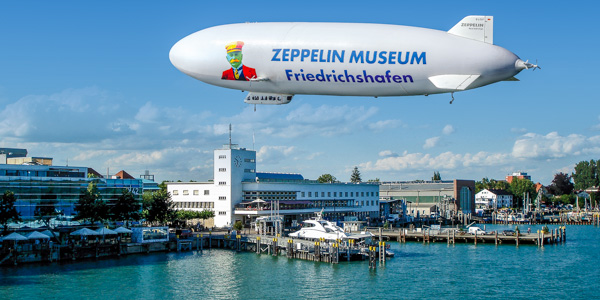
The Zeppelin Museum of Friedrichshafen. (Photo courtesy of the Zeppelin Museum, © Rolf Späth und Michael Häfner)
A glimpse in the airship era—and chance to board a replica Hindenburg—on the shores of the Bodensee (Lake Constance)
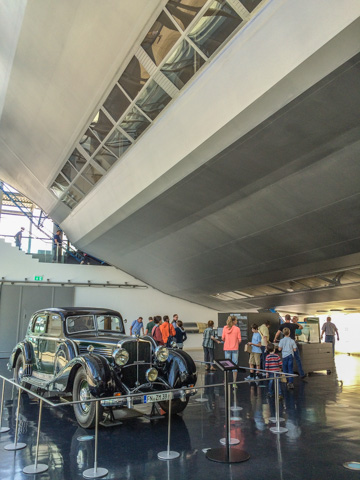
A Zeppelin motorcar beneath the recreation of the Hindenburg cabin.
Before airplanes took over the skies, mankind—or at least the very wealthy—spent a wondrous few decades swanning around the clouds aboard lighter-than-air dirigibles.
These oblong hydrogen balloons of painted canvas and aluminum struts cross-crossed the globe in near silence, made epic voyages of discovery to the Arctic, turned a three-week Atlantic crossing into a two-day journey...
...and it all came to an abrupt end after May 6, 1937, as shocking newsreel footage and Herbert Morrison's famous "Oh, the humanity!" radio coverage of the LZ-129 Hindenburg crashing and burning upon arrival in Lakehurst, NJ, swept across the planet. (Watch the video on YouTube.)
The LZ-129 Hindenburg was the largest airship ever built, 245m (803 feet) long, with a maximum diameter of 41.18m (135 feet) for a massive volume of 200,000 square meters (7,062,000 square feet).
It is difficult to describe just how mind-boggling big this thing was.
As I was standing by a section of replica aluminum framework, my museum guide pointed out the windows and and said that, had we actually been standing in that part of the Hindenburg being replicated in the museum, the airship's tail would have rested roughly where we could see a construction crane rising above the buildings... on the far side of the city's old center.
The best I can do is provide this graphic showing the four largest planes ever built compared up against this mighty airship:
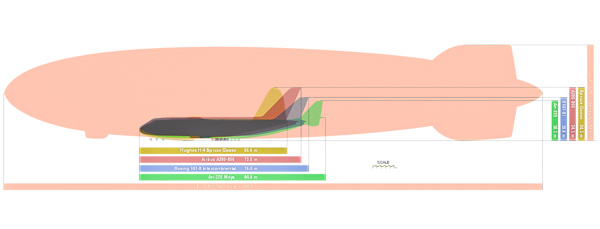
How the Hindenburg measures up. The blue is the new Boeing 747-8, the red is an Airbus 380-800, the yellow is Howard Hughes' Spruce Goose, the green is the world's largest plane, a Russian Antonov An-225 Mriya. The LZ-129 Hindenburg's the one in pink. (Image courtesy of Timmymiller)
It was the first to have a cabin actually inside the envelope (the cabin dangling off the bottom was just for the pilot)—and that cabin has been painstakingly recreated in the Zeppelin Museum of Friedrichshafen, the small city on the north shore of Lake Constance where the dirigibles were built back in the early 20th century glory days.
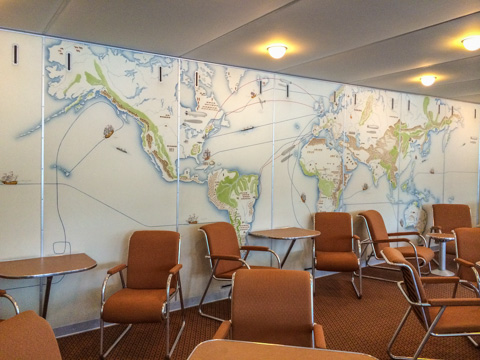
The lounge of the Hindenburg.
They used the same materials—aluminium struts, silk walk coverings—and even the same tools that were used on the original Hindenburg to create an exact replica, right down to the toilets and the Bauhaus chairs in the passenger lounge.
Definitely take a tour to learn all about this luxurious flying craft—especially the kinds of trade-offs that had to be between the science of lighter-than-air flight and the demands of wealthy passengers.
My favorites: Every material was carefully selected to be as light as possible, the design was shaved down at every opportunity, and everybody and their luggage was precisely weighed—yet they also carried 2,000 bottles of Champagne on board.
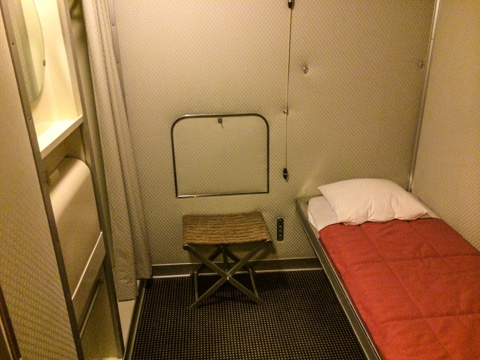
A cabin aboard the Hindenburg.
Even better: This thing was basically a gigantic Hydrogen balloon, yet there was a smoking lounge on the bottom cabin level—no, really, with an air lock and a lighter chained to the wall and a crew member whose sole job it was to stand guard and make sure nobody left the room with a lit cigar.
So it was an impressive airship, a true queen of the skies, the world's most luxurious form of fast transport, and an dizzyingly expensive ride aboard it was the ultimate status symbol.
And yet, after 14 months of crisscrossing the Atlantic ferrying well-to-do travelers between Europe and the New World (alongside its sister ship, the Graf Zeppelin), one disastrous landing ended the entire airship era overnight.
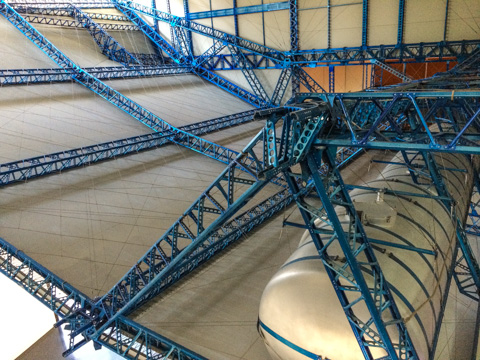
A recreation of part of the aluminum superstructure of the Hindenburg.
(Interestingly, 21 dirigibles had crashed and burned prior the Hindenburg; just none had done it so spectacularly and on camera before.)
No one actually knows just what caused the Hindenburg disaster—though there are many theories. All we know is that the Graf Zeppelin was bound for South America at the same time and, once it landed safely, no other hydrogen airship every flew commercially again. The age of the lighter-than-airship was over. (Modern blimps are actually heavier than air, and they use helium.)
Few realize that, actually, two-thirds of the people aboard the Hindenburg survived. There were 36 passengers and 61 crew, of whom 13 passengers and 22 crew (and one ground crew member) died. The rest managed to jump from the cabin windows as the ship came down and run to safety.
Many ask the question: Why fill the thing with such a flammable gas in the first place? Hadn't the Germans ever been to a kid's birthday party?
Well, for one thing helium is rather expensive, especially on an industrial scale. For another, Germany couldn't get its hands on any. In a way, you can blame some of the blame for the Hindenburg disaster on United States' Helium Control Act of 1927, which forced Germany to resort to the most abundant and cheap (yet also flammable) gas in the universe: Hydrogen.
(Fun fact: Nearly all helium on the planet comes from the U.S., a by product of natural gas mining; it is therefore expensive and controlled; we even still have a massive strategic reserve of the rare gas in the ground under East Texas, though the U.S. Government is trying to figure out how what to do with it now that we are in the jet age. There are only so many party balloons one government can use.)
Can I take a ride in a dirigible?
Of course! You can get an airship rides in a modern Zeppelin dirigible (don't worry; they use helium now)—but they don't come cheap.
Prices start at €200 per person for a 30-minute quickie over the city, €300–€400 for a 45–60 minute flight over the lake or surrounding countryside.
Head to Zeppelinflug.de for more info and to book a ride.
Tips & links
Zeppelin Museum
Seestrasse 22, Friedrichshafen
Tel. +49-(0)7541-38-010
Zeppelin-museum.de
Open daily 9am–5pm (closed Mon Nov–Apr)
Adm
Take at least an hour; 90 minutes would be better.
- SIGHTS
- Lake Constance tourist info:
- Bodensee.eu
- Oberschwaben-tourismus.de
- Konstanz-tourismus.de
- Tourism-bw.com
- Baden-Württemberg tourist info:
- Tourism-bw.com
- Germany.travel
- Stuttgart-tourist.de
- Blackforest-tourism.com
- Heidelberg-tourismus.de
- Tourismus.ulm.de
- Baden-baden.com
- Activities & tours:
- Viator.com
- ContextTravel.com
- Intrepidtravel.com
- Gadventures.com
- Infohub.com
- City-Discovery.com
- Localguiding.com
TRANSPORT
- Airfares:
- Momondo.com
- AutoEurope.com
- Vayama.com
- CheapOair.com
- Cheapflights.com
- DoHop.com
- CheapTickets.com
- Priceline.com
- Airports:
- Stuttgart-airport.com, Fly-away.de (Lake Constance); Other airports within 200km: Frankfurt-airport.com, Euroairport.com (Basel), Munich-Airport.com, Zurich-airport.com
- Car/RV rentals:
- Autoeurope.com
- Momondo.com
- RentalCars.com
- CheapOair.com
- AutoSlash.com
- Trains:
- Bahn.de
- Raileurope.com
- Seat61.com
- Apartments & villas:
- Vrbo.com
- Booking.com
- Venere.com
- Rentalo.com
- Homeaway.com
- Belvilla.com
- Interhomeusa.com
- Airbnb.com
- Villasintl.com
- Craigslist.org
- Hostels & campgrounds:
- Hostelworld.com
- Gomio.com
- Hostelbookers.com
- HostelsClub.com
- Hostelz.com
- Booking.com
- Venere.com
- Agriturismo (farm stays):
- Landtourismus.de
- Bauernhofurlaub.de
- Booking.com
Related Articles |
|
This article was by Reid Bramblett and last updated in July 2014.
All information was accurate at the time.
Copyright © 1998–2013 by Reid Bramblett. Author: Reid Bramblett.
Seestrasse 22, Friedrichshafen
Tel. +49-(0)7541-38-010
Zeppelin-museum.de
Open daily 9am–5pm (closed Mon Nov–Apr)
Adm
